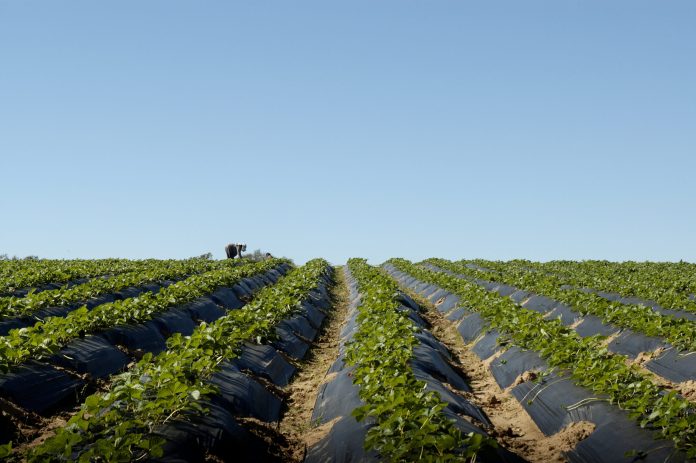
When methyl bromide was banned in 2005, California strawberry growers lost an effective tool in their crop care toolbox to control weeds, soilborne diseases, nematodes and symphylans. Special-use permits allowed them to continue using the fumigant through 2016, but growers feared final loss of the powerful soil fumigant might be the end of profitable production.
The California Strawberry Commission agreed, noting that elimination of methyl bromide fumigation brought forth several soilborne diseases for which there is no post-plant control. Of particular concern were Fusarium wilt (Fusarium oxysporum f.sp. fragariae), Verticillium wilt (Verticillium dahlia) and charcoal rot (Macrophomina phaseolina), according to the California Strawberry Commission.
But once again, necessity proved to be the “mother of invention,” said independent agronomist and PCA Lee Stoeckle, owner of Stoeckle Agricultural Consulting in Ventura, Calif.
Stoeckle has advised strawberry and caneberry growers for more than 30 years, and he noted that effective alternative fumigants have taken up the methyl bromide void and are now widely and successfully used. While California strawberry acreage has fallen, total production has actually increased thanks to innovation and application of new technology.
Stoeckle’s family-owned business provides recommendations on 3,000 acres of strawberries and 100 acres of blackberries in Santa Barbara County and San Luis Obispo County and 2,000 acres of strawberries in Ventura County. In addition, he consults on production of 800 acres of strawberry and 250 acres of raspberries in Baja Mexico. While he is primarily responsible for above-ground insect and disease control, he doesn’t write fumigation recommendations but instead advises based on what he learns about weeds and soil pathogens.

A One-Two Punch
Top problem soilborne diseases, according to Stoeckle, are Fusarium, Macrophomina, Phytophthora, Anthracnose and Verticillium wilt. Top problem above-ground pests include two-spotted spider mites, Lygus bug, Botrytis fruit rot/gray mold and powdery mildew, depending on varietal susceptibility. Other pests necessary to watch include worms and aphids.
“The optimum disease and weed control program is a one-two punch,” Stoeckle says. “Hit it at the end of the season as a burndown and at the beginning before next planting via drip irrigation. The backbone of our control program is Pic-Chlor 60 EC (1,3-dichloropropene plus chloropicrin) at the max recommended rate (350 lbs/ac), going after the heavy hitting ‘big boys’ (soilborne diseases) when applied in August or September before planting.” He recommends Vapam or K-Pam to get the additional benefits to control these diseases (Fusarium, Verticillium, Macrophomina phacelia) and eliminate the inoculum reservoir in the crown.
Stoeckle says emulsified formulations of Telone® C-35 and chloropicrin can be applied with irrigation water through drip irrigation systems. Metam sodium is the active ingredient in Vapam® HL™ and metam potassium in the active ingredient in K-Pam® HL™. Both are AMVAC® soil fumigants, which give off methyl isothiocyanate (MITC) when combined with water via drip or otherwise. If drip fumigation is planned, good results have been obtained with a sequential application of chloropicrin or 1,3-dichloropropene plus chloropicrin, followed 7 days later with metam sodium or metam potassium.
Stoeckle considers fumigants essential and offers the math: “If we equate the value of every plant to be $2 each and you lose 10% of your plants, that’s 2,500 plants on a population of 25,000 per acre. Your choice is to fumigate or take a $5,000 loss. That’s an easy decision. The return on investment on fumigation is huge. We expect to see a 20% to 30% return on fumigant investment.”
He is quick to add there are other management decisions that help maximize production, noting, “I could go on and on about using the best plastic mulch or optimum fertilization practices.”
Best Practice Weed Control Reduces Production Costs
Fifth-generation Santa Barbara County grower Brett Ferini, owner of Rancho Laguna Farms, grows 400 acres of strawberries (300 fall plant, 100 summer plant) and 20 acres (adding another 20 for 40 total) of blackberries. Plus, he grows 35 acres of organic blackberries. He used Vapam on blackberries in February 2020.
“Vapam worked out really well in controlling nutgrass/nutsedge,” he said. “Pic-Clor 60 has no effect.”
For weed and disease control, “we hit everything at fall pre-plant with Pic-Clor 60 through drip tape and seven days after that we follow with Vapam,” he said. “It does a terrific job on nutsedge and other weeds, as well as the soilborne diseases including Verticillium, Phytophthora and, anecdotally, Macrophomina.”
Ferini says the operation plans to add a Vapam burndown at the end of the 2020 growing season
“We definitely [have] cut weeding by 60% on summer plant,” he says. “Labor is our highest cost. We saw $1,050 savings per acre vs. our normal costs of $1,800/acre. The big test will be on the fall plant when we get more rain. Our fall weeding cost normally runs $2,800 to $3,000 per acre. Using Pic-Clor 60 followed by Vapam treatment, I expect weeding cost savings of $1,000 to $1,500 per acre.”
Also seeing results with soil fumigants is Santa Barbara grower Josh Ford. He is COO of Ocean Breeze Ag Management LLC in Ventura, which grows 450 acres of strawberries, 50 acres of blackberries, and 25 acres of raspberries. Ford’s biggest soilborne pests are Macrophomina, Fusarium, and Phytophthora cactorum. Nutgrass is his most difficult weed to control.
“We’ve been using soil fumigants for many years,” he says. “We were using methyl bromide, but now we apply chloropicrin once a year and K-Pam once to twice a season. If nut grass is a bad problem, we will knock it down at the end of the season with K-Pam and also pre-plant K-Pam. Our ROI is good when you consider the increased cost of labor to manually remove nut grass.”


















